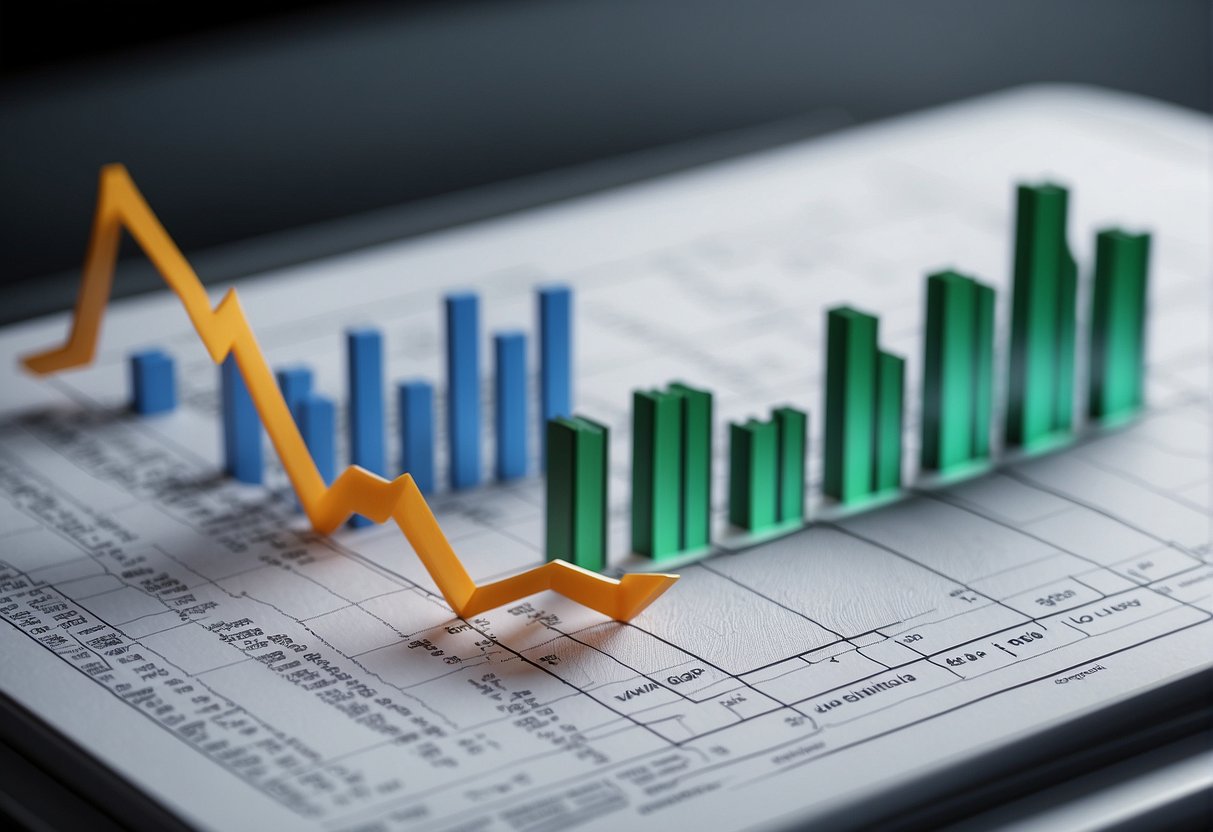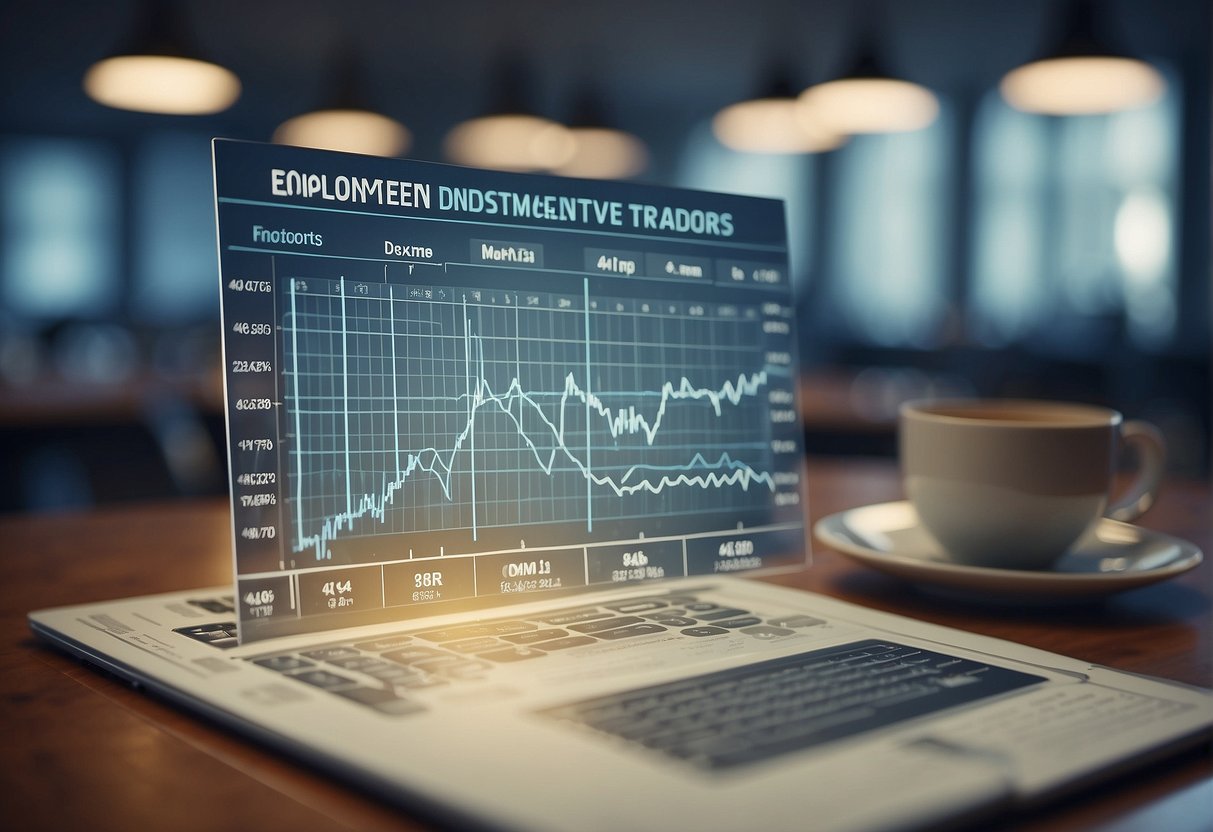Various economic indicators often influence market timing decisions, as investors and traders alike aim to make well-informed choices in the financial market. Economic indicators are crucial data points that help understand current or potential investment possibilities. Market participants forecast trends and make strategic decisions regarding asset allocation by analyzing these indicators.

Several key economic indicators are involved in market timing. These include factors such as GDP growth, employment statistics, inflation rates, interest rates, trade balances, and consumer spending trends. These data points provide a comprehensive understanding of the overall economic climate and allow individuals to make more informed decisions when entering or exiting the market.
Furthermore, corporate earnings reports, stock indices, and government policies also significantly impact the timing of trades and investment strategies. These additional factors and the leading economic indicators paint a complete picture for investors and traders to recognize market trends, cycles, and potential opportunities.
Key Takeaways
- Economic indicators are vital in influencing market timing decisions for investors and traders.
- Various factors, such as GDP, employment, inflation, and interest rates, help market participants assess the overall economic climate and trends.
- Additional factors, including corporate earnings reports and government policies, aid in recognizing market trends and opportunities for strategic asset allocation.
Understanding Economic Indicators
Economic indicators are essential for investors and policymakers to make informed decisions about market timing and monetary policies. They provide insights into an economy’s health and direction, helping them anticipate changes that could affect their investments or policy decisions.
Types of Economic Indicators
There are three main types of economic indicators: leading, lagging, and coincident indicators.
- Leading indicators are the first to change and can help predict future economic trends. They signal potential shifts in the economy before they occur, which can be helpful for short-term predictions and making proactive decisions. Examples of leading indicators include stock market indices, building permits, and manufacturing orders.
- Lagging indicators tend to change after the economy has begun following a particular trend. They help confirm and measure the health of the economy and the effectiveness of policy changes. Some examples of lagging indicators are unemployment rates, consumer price index (CPI), and corporate profits.
- Coincident indicators move in tandem with the overall economy, providing real-time data on the current state of the economy. Examples of coincident indicators include GDP, employment rates, and industrial production.
Interpreting Economic Data
Interpreting economic data and the relationship between financial indicators is crucial to making informed decisions. Here are some tips for using economic indicators effectively:
- Look for patterns and trends: Analyze how the indicators move about each other and the broader economic context. For instance, a consistent rise in leading indicators could signal an upcoming economic expansion.
- Consider multiple indicators: Relying on one indicator might not provide a complete picture of the economy. Reviewing multiple indicators within each category (leading, lagging, and coincident) can help to develop a more holistic understanding of the current economic situation.
- Be Aware of limitations: Economic indicators can give valuable insights but are not foolproof. Acknowledge the limitations and potential biases in data collection and interpretation, and use the indicators as a guide rather than an absolute truth.
In conclusion, understanding the different types of economic indicators and how to interpret their data is an essential skill for investors and policymakers. By analyzing leading, lagging, and coincident indicators, one can make better decisions about market timing and the economy’s overall health.
The Impact of GDP on Market Timing

GDP Growth and Stock Prices
Gross Domestic Product (GDP) is a crucial economic indicator that broadly determines a nation’s health. It directly affects the stock market, influencing investors’ market timing decisions. Strong GDP growth usually signifies a thriving economy, which, in turn, positively impacts the stock market. In contrast, weak or negative GDP growth may signal a slowing or contracting economy, hurting stock prices.
When GDP growth is robust, businesses generally experience increased revenues and profits, leading to higher stock valuations. As a result, investors may see this as an opportunity to adapt their investment strategies and take advantage of market upswings.
Real GDP and Investment Decisions
Investors consider Real GDP, adjusted for inflation, to make informed investment decisions. Investors can better time their market decisions by observing the relationship between real GDP growth and stock market trends. For instance, strong real GDP growth often results in:
- Increased corporate earnings: Companies benefit from a growing economy that can propel stock prices.
- Potential interest rate changes: Central banks may raise interest rates to control inflation during periods of solid GDP growth, affecting companies’ borrowing costs and altering the investment landscape.
In contrast, weak or negative real GDP growth can result in:
- Decreased corporate earnings: Companies face a more challenging business environment, potentially causing stock prices to decline.
- Potential interest rate decreases: Central banks may lower interest rates to stimulate economic growth, impacting companies’ and investors’ borrowing costs and investment decisions.
By closely monitoring GDP growth and its impact on stock prices, investors can make more informed decisions about their market timing and investment strategies.
Employment Indicators and Investment Strategies

Unemployment Rate and Market Sentiment
The unemployment rate is a crucial economic indicator influencing investor sentiment and market timing decisions. A high unemployment rate can signal potential economic weakness, whereas a low rate may suggest a healthier and growing economy. Investors often use this data to adjust their portfolios, considering the economy’s general health and potential risks associated with high unemployment.
For example, during periods of high unemployment, investors may shift their focus towards more defensive assets like bonds or cash. Alternatively, with low unemployment rates, they may invest in sectors expected to benefit from a robust labor market and increased consumer spending, such as consumer discretionary stocks.
Labor Market and Economic Health
Apart from the unemployment rate, various other labor market indicators can provide insights into the overall economic health. These include job creation numbers, wage growth, labor force participation, and involuntary part-time workers.
Job creation numbers help investors gauge the strength of the labor market. For instance, a consistently increasing number of jobs added each month can indicate an expanding economy, leading investors to develop more aggressive investment strategies focused on growth stocks. On the other hand, a decline in job additions might prompt a more cautious investing approach.
Wage growth is another significant indicator, as it directly impacts consumer spending and contributes to overall economic growth. Strong wage growth can signal that consumer demand will be robust, benefiting businesses and the stock market. In contrast, stagnant wages can suggest a slow-growing economy, leading to more prudent investment strategies.
The labor force participation rate reflects the percentage of the working-age population that is either employed or actively seeking employment. A high participation rate implies a significant percentage of the population is engaged in the labor market, which may indicate robust economic health. Conversely, a low labor force participation rate can imply weak financial health, leading investors to reevaluate their investment strategies based on these market conditions.
In summary, employment indicators play an essential role in influencing market-timing decisions. Investors can use these indicators to adjust their investment strategies, considering factors such as unemployment, labor market strength, and overall economic health. By closely monitoring these indicators, investors can make more informed decisions, positioning their portfolios for optimal returns in different market conditions.
Inflation and Its Influence on Markets
Consumer Price Index (CPI)
The Consumer Price Index (CPI) is a widely used economic indicator that measures the overall change in prices of commodities consumers buy for their daily consumption. CPI contributes significantly to monitoring inflation. In essence, it tracks the purchasing power of a currency over time, helping investors and policymakers determine an economy’s vitality. A rise in the CPI suggests an increase in the inflation rate, which often impacts the stock market.
Year-over-year changes in inflation rates can influence investors’ market timing decisions. When the inflation rate rises, investors may shift their perspective towards more secure options, like gold or real estate, to hedge against currency depreciation. Conversely, if the inflation rate is stable and within the target range (for example, around 1% to 3%), it could indicate that the economy is growing at a healthy pace, fostering a positive environment for investing in stocks.
Producer Price Index (PPI)
The Producer Price Index (PPI) is another critical economic indicator that measures the price changes in goods and services at the wholesale level. Unlike the CPI, which focuses on the end consumers, PPI tracks changes in the cost of production that businesses face. PPI is equally vital in understanding inflation because it can impact consumer prices downstream.
- Rising PPI can signal increased costs for manufacturers and service providers, which may cause them to reduce production, leading to shortages in the supply chain. As a result, stock market investors may take a cautious approach by adjusting their portfolio allocations or waiting for a better entry point.
- Declining PPI, on the other hand, can suggest a decrease in input costs, which usually leads to an increase in business profit margins. This scenario often encourages investors to allocate more capital to promising stocks, anticipating improved earnings.
In conclusion, tracking CPI and PPI allows investors and policymakers to gauge inflationary trends and potential economic consequences. These indicators significantly shape market timing decisions, particularly when their patterns unveil shifts in the overall economic climate.
Footnotes
Interest Rates as a Market Guide
Federal Reserve and Interest Rates
The Federal Reserve plays a crucial role in setting interest rates by controlling the federal funds rate. This rate is the benchmark for various types of interest rates, both short-term and long-term. Interest rates reflect the cost of borrowing money and can be influenced by inflation, economic growth, and the overall financial environment.
When the Federal Reserve increases or decreases the federal funds rate, it can ripple effect on the economy. Higher interest rates make borrowing more expensive, thereby discouraging borrowing and spending, while lower interest rates incentivize spending and can stimulate economic growth.
Bond Yields and Equity Markets
The bond markets play a significant role in determining the current state of interest rates. Bond yields, especially those of Treasury bonds, can be an essential market indicator. The yield curve plots the yields of bonds with different maturities, and its shape can provide valuable insights into market expectations about the future path of interest rates.
A standard yield curve, for instance, exhibits an upward slope, with long-term bond yields higher than short-term yields. This indicates that the market expects economic growth and inflation to rise over time. An inverted yield curve, on the other hand, signals a potential economic slowdown, as short-term yields are higher than long-term yields.
Both bond yields and interest rates have a direct impact on equity markets. When interest rates rise, fixed-income investments like bonds become more attractive than stocks. This shift in investor preference can lead to a decline in stock prices. Conversely, when low interest rates, stocks appeal more than bonds, driving equity market growth.
In summary, investors must understand the influence of interest rates and bond yields on market timing decisions. By monitoring the Federal Reserve’s actions and the bond markets’ behavior, investors can make informed decisions about their investment strategies.
How Trade and International Markets Affect Timing
International Trade and Domestic Markets
International trade plays a significant role in the performance of domestic markets. As countries exchange goods and services, fluctuations in exchange rates, policies, and supply chain dynamics can impact market conditions. For instance, a strong currency can affect the competitiveness of export-oriented industries, influencing the market timing of investors.
Global economic indicators are essential for investors to consider when making timing decisions. Some key indicators include:
- Gross Domestic Product (GDP)
- Inflation rates
- Interest rates
- Employment data
By closely monitoring these indicators, investors can detect patterns and trends, helping them make more informed decisions regarding market timing.
Net Exports and Market Trends
Net exports, which equal a country’s total exports minus its imports, can significantly impact market trends. When net exports are buoyant, it signifies a trade surplus, while a negative figure points to a trade deficit. A stable or increasing trade surplus can be a positive sign for the market, encouraging investment and driving market growth.
However, shifts in trade balances are not the only factors impacting market trends and timing decisions. Investors must also take into account other external influences on international trade, such as:
- Trade policies: Changes in tariffs, regulations, and trade agreements can directly affect market conditions for companies involved in international trade.
- Supply chain disruptions: Events such as natural disasters, pandemics, or geopolitical conflicts can disrupt global supply chains, impacting market performance and timing decisions.
- Economic growth: The general state of the global economy and individual countries’ financial health can influence markets. Strong economic growth can increase demand for goods and services, boosting markets and potentially altering timing decisions.
Recognizing the interconnected nature of trade, international markets, and domestic economies is essential for investors wishing to make sound market timing decisions. By monitoring critical economic indicators and understanding global trade dynamics, investors can develop a comprehensive outlook on market trends, better positioning themselves for success.
Consumer Spending and Retail Sales Analysis

Consumer Confidence and Sentiment
Consumer confidence and sentiment are crucial in consumer spending and retail sales. Consumers are more likely to spend money on goods and services when they feel optimistic about the economy and their finances. This increased spending will subsequently drive up retail sales, a critical component of the overall economic health. The U.S. GDP increased by 3.3% in the fourth quarter of 2023, indicating positive consumer sentiment.
Monitoring consumer sentiment can be done through various sources, such as:
- Surveys: Regular surveys gauge how consumers feel about their financial outlook, job stability, and overall economy.
- Retail Sales Data: Analyzing statistical measures of retail sales can provide valuable insight into consumer confidence and changes in consumption patterns.
- Consumer Price Index (CPI): Keeping an eye on inflation rates can help understand consumer purchasing power and the impact of the economy on consumers’ daily lives.
Durable Goods Orders
Durable Goods Orders are another essential economic indicator that influences market timing decisions. As these orders report the demand for long-lasting goods expected to be in use for more than three years, they can act as a gauge for future manufacturing activity – and, consequently, overall economic health.
Higher durable goods orders suggest that consumers and businesses are confident in their economic prospects and are, therefore, willing to invest in long-term goods such as vehicles, machinery, and equipment. Durable goods orders data can also indicate higher consumer spending as the demand for such items often translates to increased retail sales.
To analyze durable goods orders, investors and analysts often examine the following components:
- Trends: Increases or decreases in durable goods orders over time can influence market timing decisions.
- Volatility: Market participants should consider the volatility of durable goods orders to gauge economic stability and future growth potential.
- Sector-Specific Data: Examining the demand for different categories of durable goods (such as vehicles, electronics, and machinery) can provide a clearer picture of the overall economic condition and which industries may experience growth or decline.
In conclusion, understanding consumer spending, retail sales, consumer confidence, consumption trends, and durable goods orders is essential to making informed market timing decisions. Evaluating these economic indicators provides a more comprehensive view of the current economy, helping investors navigate the market and make better-informed decisions.
The Role of Government in Market Dynamics

Policy Decisions and Economic Cycles
The government and policymakers are crucial in shaping market dynamics and timing decisions. One way they do this is by implementing policy decisions that can impact economic cycles. For instance, the Federal Open Market Committee (FOMC) is responsible for adjusting interest rates and controlling the money supply to help maintain price stability and stimulate economic growth.
During a recession, policymakers may use stimulative monetary policy measures, such as lowering interest rates or increasing the money supply, to encourage borrowing and spending. This can lead to an increase in aggregate demand, ultimately helping the economy recover. In contrast, during periods of inflation and overheating, the government may implement contractionary monetary policy measures (e.g., raising interest rates and decreasing the money supply) to slow down economic activity.
These government actions are often procyclical in nature, meaning they tend to amplify the fluctuations in an already existing economic cycle. By interpreting changes in financial data and monitoring the decisions made by central banks and other economic policymakers, investors can better anticipate shifts in market trends and make informed decisions on market timing.
Fiscal Policy and Market Reactions
Another way the government influences market dynamics is through fiscal policy. Fiscal policy involves using government spending and taxation to influence the economy. For example, when the economy is in a downturn, the government may implement expansionary fiscal policies (e.g., increased spending and decreased taxes) to boost economic activity and support economic recovery. On the other hand, during periods of high growth, it may adopt contractionary fiscal policies (e.g., reduced spending, increased taxes) to prevent overheating and inflation.
When making market timing decisions, investors often pay close attention to economic data, such as GDP growth, unemployment rates, and inflation. These indicators can provide valuable insights into the government’s likely policy choices and their potential impact on market trends.
The markets are sensitive to government actions, and fiscal policy decisions can trigger market reactions, both positive and negative. For instance, markets may react positively to expansionary policies that help stabilize economic growth. At the same time, contractionary measures might lead to concerns about reduced growth prospects and, consequently, a decline in market sentiment.
In summary, understanding the role of government in market dynamics can help investors make more informed market timing decisions. By considering the impact of government policy decisions and economic indicators on market trends, investors can stay ahead of the curve and gain a competitive edge in their investing strategies.
Corporate Earnings Reports and Stock Movements
Corporate Profits and Market Performance
Corporate earnings are crucial in determining stock prices and overall market performance. When companies report strong earnings, it signals their financial health and growth potential, which can positively impact their stock prices. On the other hand, weak earnings indicate potential issues in a company’s operations, causing a decline in share prices. As a result, corporate profits significantly influence investor sentiment and market trends.
Additionally, economic indicators reflect the overall state of the economy and often correlate with corporate earnings. For example, during periods of economic growth, companies usually report higher profits, boosting investor confidence and driving up stock prices—conversely, lower profits and negative sentiment cause stock prices to fall during economic downturns. Thus, analyzing these indicators can help investors anticipate market trends and make informed decisions.
Earnings Seasons and Investor Timing
Earnings seasons are periods when publicly traded companies release their quarterly earnings reports. They typically occur in January, April, July, and October. For investors, these seasons are critical for gauging a company’s financial health and using this information to make market timing decisions.
During earnings seasons, market volatility increases due to many companies announcing their earnings simultaneously. This can lead to significant shifts in stock prices, presenting both opportunities and risks for investors. By closely monitoring these reports and analyzing market reactions, investors can identify trends and patterns that may further influence their market timing decisions. For example, suppose most companies within a specific sector report positive earnings. In that case, it might signal a favorable environment for that industry and prompt investors to take positions in that sector.
In summary, corporate earnings reports play a significant role in influencing stock prices and market performance. By understanding the relationship between corporate profits, economic indicators, and earnings seasons, investors can make well-informed decisions to optimize their market timing strategies.
Footnotes
Market Indicators and Asset Allocation
Evaluating Asset Classes
Market indicators are essential in evaluating and allocating assets among different asset classes within financial markets. Investors use economic data and technical indicators to identify trends and anticipate market fluctuations. For example, they may examine gross domestic product (GDP), unemployment rates, and inflation levels to predict the future direction of asset prices. By analyzing these factors, investors can decide which assets to invest in and when to enter or exit the market.
Some standard asset classes investors might consider include:
- Stocks: Represent ownership in a company, usually associated with higher risk and potential for high rewards.
- Bonds: Debt securities issued by corporations or governments, often with lower risk and fixed-income returns.
- Real estate: Physical properties such as land or buildings, valued for their potential to generate rental income and appreciate over time.
- Commodities are basic goods like oil, gold, or agricultural products that may be subject to price fluctuations based on supply and demand factors.
Diversification and Risk Management
A key component of successful investing is diversification and risk management strategies. By allocating assets across multiple asset classes, investors can reduce the overall risk of their portfolio. Each asset class has risks and rewards, so spreading investments across various options can help mitigate potential losses.
Investors must pay close attention to market indicators to make well-informed asset allocation decisions. For example, if a certain market is predicted to experience significant growth due to strong economic indicators, investors may choose to allocate a larger percentage of their portfolio to that market. On the other hand, if a market is showing signs of weakness, investors may decrease their holdings in that particular asset class.
A practical approach to diversification and risk management is to use a variety of market regime indicators to evaluate the current financial market conditions. By understanding whether a market is in a particular phase, such as a bull or bear market, and making appropriate adjustments, investors can enhance their portfolio’s long-term performance and reduce exposure to market volatility.
Market indicators are crucial for evaluating asset classes and shaping diversification and risk management strategies. By maintaining a clear and confident understanding of economic and technical factors affecting financial markets, investors can make well-informed decisions and increase the likelihood of achieving their investment goals.
Stock Market Indices as Economic Barometers

The movements of stock market indices are often used as economic barometers to assess broader market trends and gauge the overall economy’s health. This section will examine two major indices, the Dow Jones Industrial Average (DJIA) and the S&P 500, and their roles as benchmarks for securities markets.
Dow Jones Industrial Average
The Dow Jones Industrial Average is a popular index that tracks 30 large, publicly-owned companies traded on the New York Stock Exchange (NYSE) and the NASDAQ. The DJIA measures the performance of these leading companies and provides a snapshot of the overall health of the stock market.
Since its inception in 1896, the DJIA has been an important indicator of market trends. Its components are in various industries, such as technology, finance, and manufacturing. This diverse representation offers a comprehensive view of the economy. However, some critics argue that 30 companies may not be enough to represent the broader stock market accurately.
S&P 500 as Market Benchmark
The S&P 500 is another widely followed index that serves as a benchmark for the U.S. stock market. Unlike the DJIA, the S&P 500 tracks the performance of 500 top U.S. companies from various sectors, making it a more comprehensive reflection of the stock market. It covers approximately 80% of the total market capitalization of U.S. equities.
Both professional and individual investors use the S&P 500 as a performance benchmark for their investment portfolios. The index helps investors gauge the overall investment landscape and evaluate individual securities’ performance against the market. The S&P 500 is often utilized to create passive investment vehicles, such as exchange-traded funds (ETFs) and index funds, which aim to replicate the index’s performance.
The Dow Jones Industrial Average and the S&P 500 are regarded as economic barometers and critical tools for market timing decisions. These indices provide valuable information on market movements, allowing investors to make informed decisions about entering or exiting specific investments, reallocating portfolios, or changing investment strategies. By understanding the significance of these benchmarks, investors can better understand the stock market and make decisions that align with their financial goals.
Timing Trades to Minimize Costs and Risks

Market timing involves strategically placing trades based on economic indicators and other factors to maximize profits and minimize losses. To effectively practice market timing, it’s essential to consider both transaction costs and potential risks.
Understanding Transaction Costs
Transaction costs are the expenses incurred when buying or selling securities. They may include brokerage fees, commissions, and bid-ask spreads. One way to minimize these costs while employing market timing strategies is carefully planning and choosing the right brokerage platform. Compare different brokers’ fees and ensure you’re using a platform that offers competitive rates.
Avoiding excessive trading is crucial, as this can significantly increase transaction costs and negate potential gains. Consider implementing limit orders, which allow you to set a specific price for buying or selling a security. This keeps you in control and prevents impulsive trading decisions.
Assessing Potential Risks
Market timing is not without risks. It involves predicting future price movements, making it susceptible to inaccuracies and market volatility. Investors should pay close attention to economic indicators and market trends to minimize losses.
Some common market indicators include interest rates, unemployment rates, and consumer sentiment. Investors should analyze these indicators to make informed decisions and consider how they’re likely to influence market movements.
For instance, if economic indicators suggest a potential market downturn, investors may opt to switch between asset classes or reduce holdings in more volatile investments. This can help protect their portfolios from significant losses.
Moreover, adopting a diverse investment strategy is essential when practicing market timing. This can involve investing in various asset classes, industries, and geographic regions, ultimately reducing the portfolio’s overall risk exposure.
In conclusion, market timing can be a fruitful strategy considering transaction costs and potential risks. By understanding these factors and incorporating careful planning and analysis, investors could maximize profits and safeguard their investments.
Recognizing Market Trends and Cycles

Understanding market trends and cycles is important for making informed decisions when investing in the stock market. This section aims to provide insight into identifying bull and bear markets and the influence of economic cycles and trends on market timing decisions.
Identifying Bull and Bear Markets
A bull market is when stock prices rise, investor confidence is high, and the economy grows. On the other hand, a bear market is characterized by falling stock prices, pessimistic investor sentiment, and a contracting economy. Recognizing these market shifts can help investors decide when to buy or sell stocks.
- Bull markets typically feature:
- Economic growth
- Increased investor confidence
- Rising stock prices
- Bear markets often exhibit:
- Economic contraction
- Pessimistic investor sentiment
- Declining stock prices
Investors can track market trends by monitoring various economic indicators, such as unemployment rates, corporate earnings, and the economy’s overall strength.
Economic Cycles and Trends
Economic cycles refer to the natural fluctuations in the economy over time. These cycles are generally classified into four phases: expansion, peak, contraction, and trough. Understanding these cycles can help investors predict market trends and make better investment decisions.
- Expansion: This phase occurs when the economy is growing and is characterized by increased production, consumer spending, and employment. Stock prices are likely to rise during expansion, and bull markets are more common.
- Peak: The peak phase marks the end of an expansion and the beginning of a contraction. Stock prices can continue to rise but at a slower pace, and investors need to be cautious as the economy may begin to show signs of weakness.
- Contraction: In this phase, the economy starts to shrink, with reduced production, increased unemployment, and decreased consumer spending. Stock prices generally fall, leading to bear markets.
- Trough: The trough signifies the end of the contraction and the start of a new expansion. Stock prices may stabilize or rise, signaling a potential shift toward a bull market.
Understanding these economic cycles and the relationship between long-term economic trends can help investors make more informed decisions about market timing. By monitoring leading economic indicators and remaining aware of the current phase of the economic cycle, investors can better anticipate shifts in market trends and adjust their strategies accordingly.
Economic Analysis for Savvy Investment Decisions
Leveraging Market Sentiment
Economic indicators play an essential role in shaping market sentiment. Investors rely on these indicators to understand where the economy is headed, which can help them make informed decisions about their investments. For example, leading economic indicators can provide insights into future market conditions, making it easier for investors to adopt an investment strategy that aligns with the market trends.
Analysts often divide economic indicators into categories, such as leading, lagging, and coincident. This classification helps investors better interpret these indicators and anticipate market shifts. For instance:
- Leading indicators, such as the Purchasing Managers’ Index (PMI) and housing starts, often change before the economy starts to follow a particular trend.
- Coincident indicators change at the same time as the overall economy. Examples include industrial production, personal income, and retail sales.
- Lagging indicators tend to change after the economy has already shifted. They include metrics like the unemployment rate and consumer price index (CPI).
Understanding different economic indicators allows investors to leverage market sentiment to time their investment decisions more effectively.
Strategic Investment in Times of Uncertainty
Economic analysis becomes even more critical for investors in times of uncertainty as they seek to protect their investments and minimize risks. Assessing market conditions and understanding economic indicators during uncertain times allows investors to respond proactively to changes in the financial market. For instance, a market regime indicator can help investors characterize the current state of the market and adapt their strategies accordingly.
Here are some strategic investment approaches investors can adopt in times of uncertainty:
- Diversification: Spreading investments across various asset classes, sectors, or geographic regions can help investors mitigate risks during market fluctuations.
- Long-term perspective: Focusing on long-term growth rather than short-term gains can help investors navigate volatile markets.
- Defensive investments: Allocating a portion of the portfolio to more defensive asset classes, such as bonds or dividend-paying stocks, can provide added stability during market downturns.
In conclusion, staying informed about economic indicators and adapting investment strategies according to the market sentiment and conditions are vital for savvy investment decisions, particularly in times of uncertainty.
Frequently Asked Questions
What types of economic indicators are most critical for analyzing stock market trends?
Several economic indicators play a crucial role in analyzing stock market trends. Some common indicators include Gross Domestic Product (GDP), inflation rate, unemployment rate, consumer price index (CPI), interest rates, and retail sales. These indicators help gauge the economy’s growth, inflation, employment levels, and consumer spending patterns, influencing investor sentiment and market trends.
How do GDP growth rates impact investor strategies in the stock market?
GDP growth rates reflect a country’s economic health and can significantly impact investor strategies in the stock market. Steady GDP growth suggests economic stability and expansion, boosting investor confidence and attracting more investments. Conversely, a declining GDP growth rate may signal economic contraction, leading investors to adopt a more conservative approach or reallocate resources to relatively stable markets.
In what ways do inflation indicators shape market entry and exit points?
Inflation indicators, like the CPI and interest rates, can influence market entry and exit points. High inflation often leads central banks to raise interest rates, making borrowing more expensive and possibly slowing down economic activity. In such scenarios, investors may exit or reduce their positions in riskier assets and shift to safer investments like bonds. On the other hand, low inflation may lead to lower interest rates, encouraging borrowing and stimulating economic growth, prompting investors to enter the market or increase their stock positions.
What role do employment statistics play in determining market timing?
Employment statistics, such as the unemployment rate, are vital economic indicators affecting market timing. Rising unemployment could signal an economic downturn, decreasing consumer spending and declining corporate earnings. This may cause investors to exit the market or adopt a more risk-averse strategy. Conversely, decreasing unemployment rates suggest a strong economy, leading to increased consumer spending and higher corporate earnings, encouraging investors to enter or expand their investments in the stock market.
How do interest rate changes by central banks influence market investment decisions?
Central bank interest rate changes directly affect the cost of borrowing and the overall economic environment. When central banks increase interest rates, borrowing becomes more expensive, potentially slowing economic growth and negatively affecting stock prices. Conversely, when central banks lower interest rates, borrowing becomes more affordable, promoting economic growth and potentially boosting stock prices. Therefore, changes in interest rates significantly impact market investment decisions by influencing investors’ outlook on economic development and asset prices.
What is the correlation between consumer confidence indices and stock market performance?
Consumer confidence indices, such as the Consumer Confidence Index (CCI), measure consumers’ sentiment concerning the overall economic situation and prospects, reflecting their spending behavior. A high consumer confidence index indicates that consumers are optimistic about the economy, suggesting increased spending and higher corporate earnings, leading to a buoyant stock market performance. Conversely, a low consumer confidence index implies a more pessimistic outlook, which may result in decreased spending, reduced corporate earnings, and negative stock market performance.
Conclusion
In summary, economic indicators are crucial in influencing market timing decisions. Investors rely on indicators such as GDP, CPI, unemployment rate, interest rates, stock market indexes, and exchange rates to make informed decisions.
These indicators provide insights into a country’s economic health, subsequently enabling investors to develop more effective timing strategies. Market participants can better anticipate market trends by considering factors like technical analysis, fundamental analysis, and sentiment analysis.
Investors must closely monitor and analyze economic indicators, as they can significantly impact financial markets. Staying updated with these indicators helps make well-informed investment decisions and adapt to market changes.
Market timing remains challenging, with many professionals achieving success through strategic moves based on market predictions. Investors are encouraged to remain cautious and focus on long-term market trends while staying informed about economic indicators.
Understanding various economic indicators is critical to a comprehensive understanding of a country’s financial health, thus enhancing trading strategies. Whether a student, economist, investor, or informed citizen, it is vital to stay updated with these indicators to make educated decisions in the dynamic world of financial markets.




